
Lysiosepalum involucratum is a species of flowering plant in the family Malvaceae and is endemic to the south-west of Western Australia. It is dense, compact or spreading shrub with its young branches covered with woolly, star-shaped hairs, and has narrowly egg-shaped leaves and purple flowers usually in groups of 2 to 6.
Micromyrtus arenicola is a species of flowering plant in the myrtle family, Myrtaceae and is endemic to a small area in the southwest of Western Australia. It is an erect shrub with small, linear to narrowly egg-shaped leaves and small white flowers.
Micromyrtus greeniana is a species of flowering plant in the myrtle family, Myrtaceae and is endemic to a small area in the west of Western Australia. It is a spindly shrub with linear to egg-shaped leaves and small white or cream-coloured flowers.
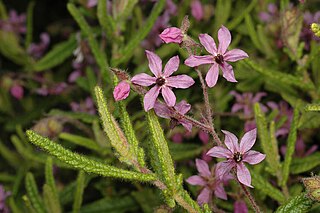
Lysiosepalum abollatum, also known as woolly lysiosepalum, is a species of flowering plant in the family Malvaceae and is endemic to a small area in the south-west of Western Australia. It is an erect, dense shrub covered with white, woolly hairs, and has narrowly egg-shaped leaves and pink, blue or purple flowers usually in groups of four or five.
Lysiosepalum hexandrum is a species of flowering plant in the family Malvaceae and is endemic to the south-west of Western Australia. It is dense, erect shrub with its young branches covered with woolly, star-shaped hairs, and has linear or narrowly elliptic leaves and blue, purple or pink flowers usually in groups of five.

Lasiopetalum glabratum is a species of flowering plant in the family Malvaceae and is endemic to the south-west of Western Australia. It is an erect shrub with densely hairy young stems, egg-shaped leaves and pale mauve-pink reddish-purple flowers.

Lasiopetalum oppositifolium is a species of flowering plant in the family Malvaceae and is endemic to the south-west of Western Australia. It is an open, erect shrub with rusty-hairy young stems, linear, narrowly elliptic or narrowly egg-shaped leaves and white, pink and dark red flowers.
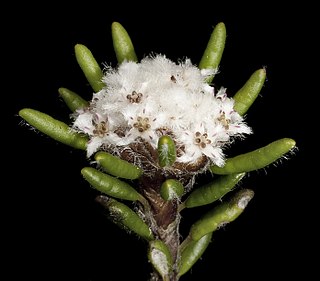
Stenanthemum humile is a species of flowering plant in the family Rhamnaceae and is endemic to the southwest of Western Australia. It is a low, erect perennial herb or shrub with white, woolly-hairy young stems, linear to narrowly elliptic leaves and densely, woolly-hairy heads of tube-shaped flowers.

Cryptandra recurva is a flowering plant in the family Rhamnaceae and is endemic to Western Australia. It is an erect, spreading shrub with densely hairy young stems, narrowly oblong to narrowly egg-shaped leaves and clusters of white, cream-coloured or off-white, tube-shaped flowers.
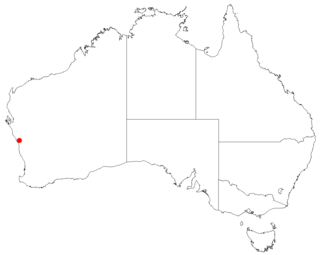
Leucopogon nitidus is a species of flowering plant in the heath family Ericaceae and is endemic to a small area in Western Australia. It is an erect, open shrub with hairy young branchlets, linear or very narrowly elliptic leaves and erect, compact clusters of 3 to 8 white flowers on the ends of branches and in upper leaf axils.
Androcalva incilis is a species of flowering plant in the family Malvaceae and is endemic to the south-west of Western Australia. It is a prostrate shrub with dark green, narrowly wedge-shaped to narrowly oblong leaves, and crowded heads of 8 to 12 deep pink flowers.
Pimelea villifera is a species of flowering plant in the family Thymelaeaceae and is endemic to the south-west of Western Australia. It is an erect, dense shrub usually with linear to narrowly elliptic leaves arranged in opposite pairs, and compact heads of many white flowers usually surrounded by 6 to 10 pairs of green and yellowish, narrowly egg-shaped involucral bracts.

Leucopogon simulans is a species of flowering plant in the heath family Ericaceae and is endemic to the south-west of Western Australia. It is an erect, open shrub with a single stem at ground level, egg-shaped to elliptic leaves and erect clusters of 3 to 14 white flowers on the ends of branches and short side-branches.

Leucopogon stenophyllus is a species of flowering plant in the heath family Ericaceae and is endemic to the south-west of Western Australia. It is an erect, open shrub with a single stem at ground level, linear, narrowly egg-shaped or narrowly elliptic leaves and erect clusters of 3 to 17 white flowers on the ends of branches and short side-branches.
Guichenotia quasicalva is a species of flowering plant in the family Malvaceae and is endemic to the south-west of Western Australia. It is a low, spindly shrub with narrowly egg-shaped to linear leaves and pink flowers in groups of two to four.
Ricinocarpos brevis is a species of flowering plant in the family Euphorbiaceae and is endemic to inland Western Australia. It is a monoecious, densely-branched shrub with narrowly oblong leaves and male and female flowers arranged singly or in small groups.
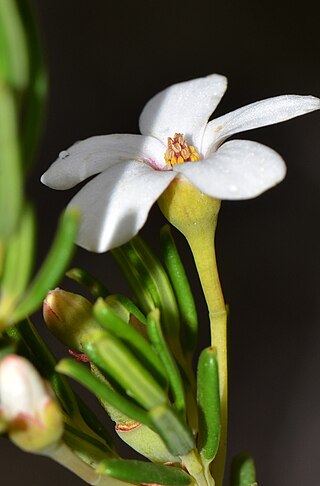
Ricinocarpos cyanescens is a species of flowering plant in the family Euphorbiaceae and is endemic to the south-west of Western Australia. It is a compact, monoecious shrub with narrowly oblong leaves and male and female flowers arranged singly or in small groups.
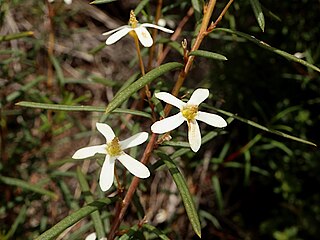
Ricinocarpos glaucus is a species of flowering plant in the family Euphorbiaceae and is endemic to the south-west of Western Australia. It is an erect, monoecious or dioecious shrub with linear or narrowly oblong leaves and male and female flowers arranged singly or in small groups.
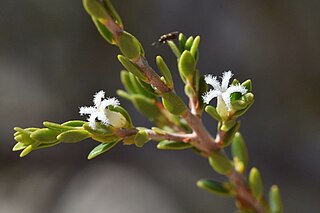
Styphelia ciliosa is a species of flowering plant in the heath family Ericaceae and is endemic to a small area of Western Australia. It is usually an erect shrub with narrowly elliptic to narrowly egg-shaped leaves with the narrower end towards the base, and white flowers usually arranged in pairs in leaf axils.
Brachyloma pirara is a species of flowering plant in the family Ericaceae and is endemic a restricted area in the west of Western Australia. It is an erect, compact shrub with sharply-pointed, linear to narrowly egg-shaped or narrowly elliptic leaves, and red, tube-shaped flowers.












